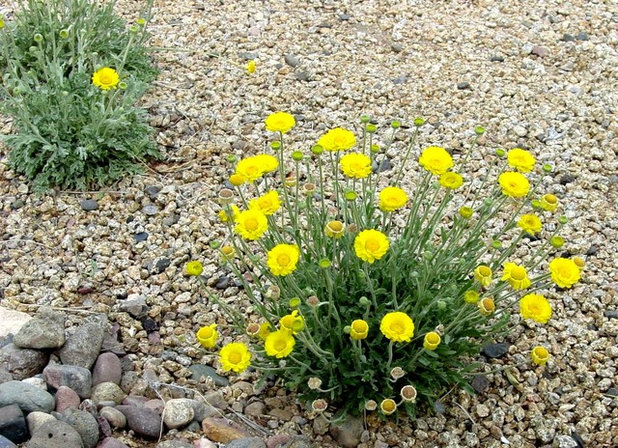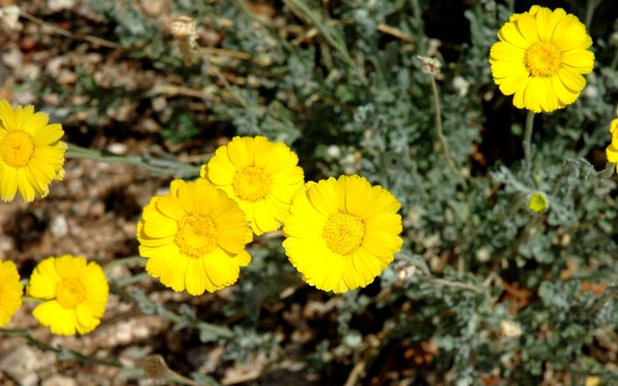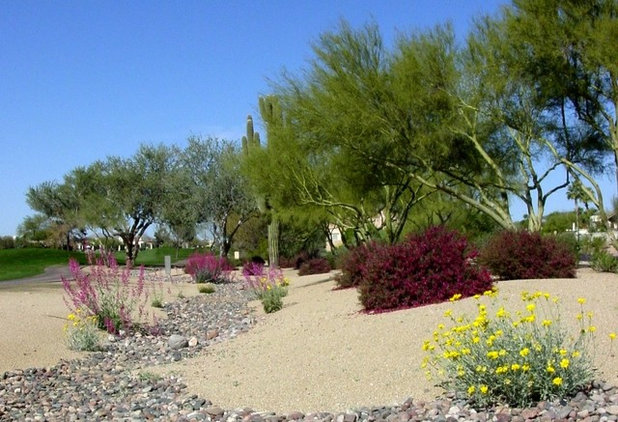The flowers of desert marigold will brighten up the landscape even where water is scarce and the sun is blazing. Often seen along roadsides, in wildflower gardens or even growing alongside cacti, desert marigold is one perennial that can handle tough, inhospitable spots while adding gentle beauty with its sunny flowers.

Noelle Johnson Landscape Consulting
Botanical name: Baileya multiradiataCommon name: Desert marigold
Origin: Native to the Southwestern United States into northern Mexico
Where it will grow: Hardy to -10 degrees Fahrenheit (USDA zone 6; find your zone)
Water requirement: Low
Light requirement: Full, reflected sun
Mature size: 1 foot tall and wide
Benefits and tolerances: Extremely drought tolerant once established; can survive on natural rainfall, but will appreciate water once or twice a month during dry periods
Seasonal interest: Flowers in spring through fall; also flowers during the winter in warmer zones
When to plant: Spring and fall; can be grown from seed or transplants

Noelle Johnson Landscape Consulting
Distinguishing traits. The delicate beauty of the yellow daisy-like flowers belies the ability of desert marigold to thrive in inhospitable conditions. Rocky soil, reflected sun and little water don’t bother this tough perennial once it is established.
During the warm season, its sunny flowers can be seen along roadsides, in wildflower gardens and alongside cacti in both residential and commercial landscapes.
Desert marigold is short lived, but it does reseed easily, ensuring new plants. Bright yellow flowers are borne above foliage covered in tiny, white hairs, giving it a gray-green appearance.
While desert marigold can often survive on natural rainfall once established, it does appreciate supplemental water once or twice a month when rainfall is absent. Avoid overwatering, which can kill it.

Noelle Johnson Landscape Consulting
How to use it. Because desert marigold reseeds readily, it is more suitable for landscapes with a natural desert theme or wildflower gardens than formal landscapes, where it can be viewed more as a weed.
Desert marigold is a popular component of many wildflower seed mixes, so be sure to include it in your favorite wild seed mixture when sowing seeds in the fall.
Pair it with
blackfoot daisy (
Melampodium leucanthum), firecracker penstemon (
Penstemon eatonii), globe mallow (
Sphaeralcea ambigua) and
verbena (
Glandularia species)
for an informal desert flower garden.
You can also use it to add color and soft texture in landscapes filled with cacti such as
cholla, ocotillo and Santa-Rita prickly pear.
When the flowers start to fade or the foliage becomes dry and straggly, shear desert marigold to 6 inches to rejuvenate it.

Noelle Johnson Landscape Consulting
Planting notes. While desert marigold often grows from seed in recently disturbed areas such as roadsides, it can also be transplanted from containers.
Select an area that receives full sun and has well-drained soil. Be careful to keep desert marigold away from areas that are frequently watered, or it will become straggly and won’t produce flowers.
If you plant it from seed, water it every few days until the seed has germinated. Thereafter water twice a week for the first month and then once a week until it can survive on its own — typically three months after planting.
Newly planted transplants require supplemental water until becoming established in the new location. Water twice a week for the first month, then taper off to once a week and then gradually to once a month.
See more U.S. native plants





